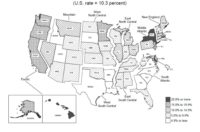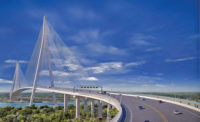Coastal Internet Infrastructure at Risk Due to Sea Level Rise

The overlap of internet infrastructure and seawater in New York City (left) and Miami (right) showed an average sea-level rise of six feet in the combined ArcGIS map.
GIS MAP COURTESY OF LIGHTS OUT: CLIMATE CHANGE RISK TO INTERNET INFRASTRUCTURE
A study from the universities of Wisconsin and Oregon used GIS to show network infrastructure could be underwater in as little as 15 years.
Because of rising sea levels, 1,186 miles of long-haul fiber-optic conduit and 2,429 miles of metropolitan fiber conduit in coastal areas of the United States will be underwater as soon as 2033, according to a study released in July by the University of Oregon and the University of Wisconsin-Madison.
Called “Lights Out: Climate Change Risk to Internet Infrastructure,” the study merges two data sets using ESRI’s ArcGIS mapping and infrastructure software. The first is fiber conduit and termination point data from the Internet Atlas, which includes geocoded maps of over 1,500 internet infrastructure networks worldwide. The second is sea level rise inundation (SLRI) data from the National Oceanic and Atmospheric Administration’s Digital Coast project, which includes a collection of geo-based sea level-rise data projections for the entire U.S. over the next century.
To assess the risk, the authors created a Coastal Infrastructure Risk metric that considers the combination of the scope and density of internet infrastructure in a certain area. The results identified communication infrastructure in New York City, Miami and Seattle as most at risk, in that order. Vulnerable individual service providers for infrastructure in those cities include CenturyLink, Intelligent and AT&T.
“I think providers are looking at this in a positive way,” says Ramakrishnan Durairajan, an assistant professor in the Dept. of Computer and Information Science at the University of Oregon, who co-authored the paper with University of Wisconsin-Madison professors Carol Barford and Paul Barford. “So, that’s very much what we wanted from this paper. We need to get the message out saying that, ‘guys, you have to think about not just hurricanes, but also sea-level rise in many of these coastal areas and what that will do to connectivity,’ and the response has been positive so far.”
The paper looked at the optical fiber strands that carry internet traffic between colocation facilities and points of presence (PoPs) and what risk being submerged might bring. The study notes that standard internet infrastructure deployments are designed to be weather and water resistant, but they are not designed to be submerged in water.
Durairajan said ArcGIS overlap models of the SLRI and Internet Atlas data sets were created to capture and analyze the risks of climate change-related sea-level rise. PoPs, data centers, landing stations and internet exchange points overlapping with the projected sea-level rise were considered more at risk than others that the overlap models showed would remain dry or merely threatened by sea-level rise. By 2030, according to the study, about 771 PoPs, data centers, internet exchange points and landing stations will be underwater, as they overlapped with the projected sea level-rise scenarios.
As many as 780 PoPs and 242 data centers will be surrounded by 4 ft of seawater by 2075, according to the study. Six ft of seawater will affect 788 PoPs and 249 data centers by the end of the century, the data predicted.
The analysis does not consider efforts to harden or fortify computer networks, and Durairajan noted many ISPs and infrastructure owners have recently completed new networks or network upgrades in the most at-risk areas not taking into account sea-level rise.
Speaking at the DA Davidson Engineering and Construction Conference last year in Chicago, Jose Mas, CEO of Coral Gables, Fla.-based MasTec, called Verizon his company’s largest customer and its aggressive fiber expansion plans a key opportunity for his company.
“What 5G means to Verizon is helping Verizon business,” Mas said. “We continue to see strong nationwide fiber deployment projects from both telephone companies and cable TV companies, and I’m confident this will provide us with significant opportunities for years to come.”
MasTec also does line work for AT&T through its DirecTV subsidiary.
“Given the large number of nodes and miles of fiber conduit that are at risk, the key takeaway is developing mitigation strategies should begin soon,” Durairajan says. “I hope that’s one of the outcomes from this paper. I hope that it capitalizes the effect of creating new climate solutions, hardening infrastructure solutions, some sort of new technologies. That’s the whole point basically.”






